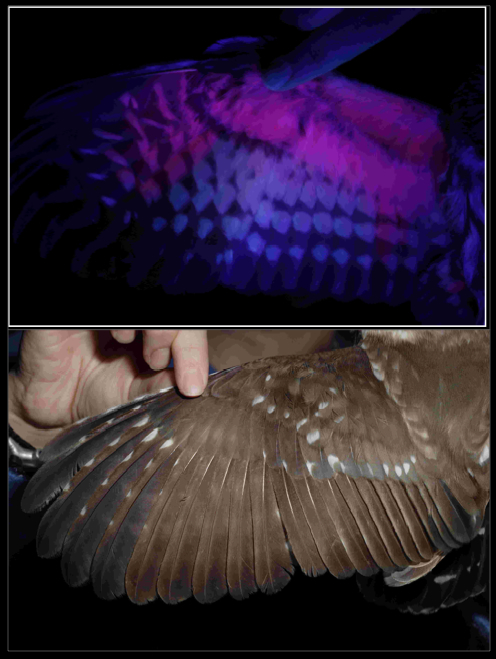Under Bird Banding Lab criteria, what is a hatching-year bird (including a Northern Saw-whet Owl) on 31 Dec. begins its second calendar year of life in 1 Jan. and is then classified as second-year, or SY. This is an administrative change, so to speak – the owl undergoes no overnight plumage change from HY to SY on 1 Jan. “Thus, in January a bird hatched the previous June would be in its second calendar year, although it is actually only seven months old.” (North American Bird Banding Manual vol. 1)
Therefore, a saw-whet owl with relatively uniform, unworn dark flight feathers, netted from 1 Jan. through the end of spring migration in April or May, should be classified as SY. As the year progresses, banders should expect to see increasing wear in the flight feathers of SY saw-whets, and increased fading of the upper flight feather surfaces. The relatively bright, even UV fluorescence on the underside of the wing will fade substantially through the winter and into the spring.

Autumn SY (second-year) saw-whets exhibit bright UV fluorescence on the outermost primaries and innermost secondaries. P6 is the most recently molted, and fluoresces most intensely. (©Scott Weidensaul)
Typically, adult Northern Saw-whet Owls have one prebasic molt a year, beginning around the time their chicks fledge. Complete loss of the rectrices, which occurs near the beginning of this molt, is essentially simultaneous. Replacement of the primaries and secondaries is usually incomplete, focused on outer primaries and inner secondaries, resulting in wings that exhibit a characteristic pattern of faded retained juvenal feathers in the middle of the wing and newly replaced outermost primaries and innermost secondaries grown as part of the second prebasic molt.
SY saw-whet owls netted on the breeding range will be molting from approximately late June through as late as August. Most body contour feathers are also replaced during the prebasic molt. Extra care should be exercised when assigning age class to actively molting Northern Saw-whet Owls between June and August, because the individual owl may not present molt patterns that banders are accustomed to seeing during autumn migration.
From September through December, after completion of its second prebasic molt, a Northern Saw-whet Owl presents the characteristic pattern of old and new primaries and secondaries described above. When viewed in natural light or under artificial white light, these molt limits are not always easy to see. Viewing the underside of the wing in a darkened area with UV light will reveal a striking pattern of new, brightly fluorescing feathers contrasting with the more weakly fluorescing older feathers. During autumn migration the typical SY saw-whet owl will have replaced primaries 6 through 10 and secondaries 8 through 12; although there is considerable individual variation.


